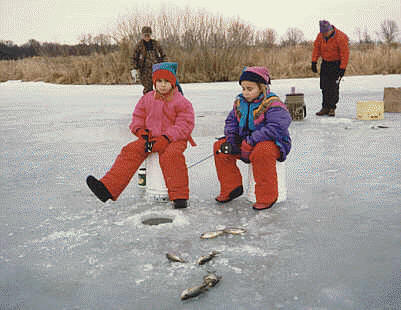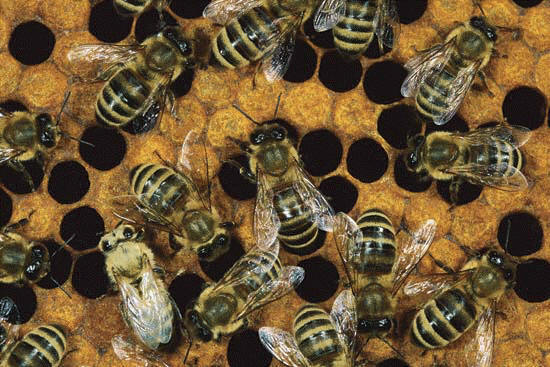|
|
|
Chapter 1: Ice Fishing |
|

|
Read the passage. Then answer questions about the passage below. |
Proyecto Salón Hogar
|
The first tip for a good day of ice fishing is to wear the right clothes. You should dress in layers. Wear 2 or 3 shirts, so you can take off a layer when you are warm. Wear a face mask, a warm hat with ear flaps over your ears, and warm gloves and boots. The second tip is to stay warm. Some people put up cloth tents when they go ice fishing. Some people
own small ice houses where they can stay warm. You can use a small heater inside the tent or outside on the ice. Be sure
to take a hot drink like hot chocolate. You should move around to stay warm.
Some people take ice skates. The third tip is to check the ice. Look at it carefully. The ice must be 4 or more inches thick. This is the ice rule: “Thick and blue, tried and true. Thin and crispy, way too risky.” Thick ice is safe for ice fishing. Thin ice is dangerous. The fourth tip is to take the right tools. You need to drill a hole in the ice with an ice drill. Then make the hole bigger with a chopping tool, like an ax.
You need to carry your bait in a bait bucket. Use worms or small fish for bait. You need a chair to sit on. Take a folding chair so you can carry it easily. Be sure to take your fish hooks and fishing rod! Pull all your tools on a sled. Take your cell phone. You might need to call for help.
The fifth tip is to have a great time!
1) You need ear flaps over your ears to… B. protect your ears from noise. C. keep your ears warm. D. Both A and B are correct.
2) You should move around to… |
Page 1
![]()
|
3) How should you check the ice?
5) How thick must the ice be? Vocabulary
3) Something that is risky is… |
Page 2
![]()
|
4) What is bait?
A. you should take ice fishing. B. you can fold to make
smaller. Bees
Read the passage. Then answer questions about the passage below.
Bees are insects. Bees are special insects because they can fly! They can move through the air like an airplane! Bees can fly because they have wings. They use their wings to fly. Bees can fly fast. Bees can also fly slow. They can fly up and they can fly down. They need to fly to get to the flowers! Bees can have three colors. They can be yellow, red, and orange.
All bees are black in some places. Bees have three main parts. They have a head. They have a body. And, they have a stinger. The stinger is used to defend against enemies. They also have six legs. They use their legs to stand and climb. They also use their legs to eat and collect pollen. Bees live in many places.
They live in Africa, Australia, Asia, Europe, North America, South America. The only continent that bees do not live on is Antarctica! I understand why they don’t live in Antarctica. It’s too cold! Most of the time, bees are nice to humans. If you do not bother them, they will not bother you. Have fun watching the bees this summer! |
Page 3
![]()
|
Questions
4) What is the stinger used for?
|
||||||||||||||||||||||||||||||||||||||||||||||||||
|
Page 4
Page 5
|
||||||||||||||||||||||||||||||||||||||||||||||||||
|
The Author An author is a person who writes a story or another text. Authors write many different kinds of texts, such as novels, stories, essays, articles, songs, poems, and plays. Authors usually love to read literature, and they enjoy creating thoughts and ideas with words.
The Reader A reader is the person who is reading a story or other forms of reading. Many readers like certain kinds of readings. Some people like short stories, while others may like the newspaper. Some people read for enjoyment while others read for gaining knowledge.
Types of reading: story, novel, essay, poem, reference, and article.
1. Describe in a complete sentence your reading preference. __________________________________________________________________________________________
2. In a complete sentence describe what book you would need for defining a word you do not know. __________________________________________________________________________________________
|
||||||||||||||||||||||||||||||||||||||||||||||||||
|
Page 6
|
||||||||||||||||||||||||||||||||||||||||||||||||||
|
|
3. Write your own story about something that happened in your life. __________________________________________________________________________________________ __________________________________________________________________________________________ __________________________________________________________________________________________ __________________________________________________________________________________________ __________________________________________________________________________________________ __________________________________________________________________________________________
4. How do you think others will think of your writing? __________________________________________________________________________________________ __________________________________________________________________________________________ __________________________________________________________________________________________
The Dictionary
A dictionary is a reference book that contains words
listed in alphabetical order and information about each word.
Example: realize
(ree-uh-lahyz)
verb,
to grasp or understand clearly.
Look at this dictionary entry and answer the questions below.
business [biz-nis]
noun |
|||||||||||||||||||||||||||||||||||||||||||||||||
| Page 7
|
||||||||||||||||||||||||||||||||||||||||||||||||||
|
|
1. What is the definition of the word business? __________________________________________________________________________________________ __________________________________________________________________________________________
2. Is a business also a building or is it only a company? __________________________________________________________________________________________
3. How do you write the pronunciation of the word business? _____________________________________________
4. What part of speech is the word business? __________________________________
The Dictionary: Guide Words Guide words are the two words at the top left and right hand side corners of a page. They are usually the first and last entry of that page. They help you find quickly the word you are looking for. The words in the dictionary are listed in alphabetical order; so on each page you will find the words that are between the guide words. Example: The
guide words may be walk and water, but in the
page you will find wall, walrus, waste.
Read the guide words and check the words in your dictionary that are found in the page. 1. engrave - enlivenment
|
|||||||||||||||||||||||||||||||||||||||||||||||||
| Page 8
|
||||||||||||||||||||||||||||||||||||||||||||||||||
|
|
Look up these words in the dictionary and write the guide words that appear on the page. Define the words. 1. uneven __________________________________________________________________________________ __________________________________________________________________________________________
2. huge ____________________________________________________________________________________ __________________________________________________________________________________________
3. boss ____________________________________________________________________________________ __________________________________________________________________________________________
Sentences and Sentence Fragments A sentence is a complete thought composed of a group of words. Rarely it can also be one word.
Example: We like to go to the park. A sentence fragment is an incomplete
thought that makes no sense. A sentence fragment often lacks a
subject or a Example: Ice cream good.
Mark the sentences (S) for complete sentence and (SF) sentence fragment. __ 1. No! __ 2. Cake good. __ 3. When I go. __ 4. I like candy. __ 5. My dad is nice. __ 6. River rapid. __ 7. When I see them then. __ 8. Also they are. __ 9. Dogs are fun. __ 10. The game is over.
|
|||||||||||||||||||||||||||||||||||||||||||||||||
| Page 9
|
||||||||||||||||||||||||||||||||||||||||||||||||||
|
Types of Sentences There are four different types of sentences and they can be classified according to their purpose. Each sentence has its own thought.
Example: My
house has four bedrooms and two bathrooms. Interrogative sentences are asking questions and always ends with a question mark (?). Example:
Why are you sitting in the rain? Exclamatory sentences show strong feeling and always end with an exclamation point (!). Example:
Wow, what a great day! Imperative sentences are giving commands and can end with a period (.) or an exclamation point (!).
Example: Go close the door.
Mark the following sentences, D for declarative, IN for interrogative, E for exclamatory, or IM for imperative. __ 1. At six o' clock we are going to eat. __ 2. That flower is very beautiful! __ 3. When are we going home? __ 4. Get back to work! __ 5. She likes to walk in the park. __ 6. Mr. Cillo is a very persistant man. __ 7. Where are going mother? __ 8. I am going to eat some pizza later. __ 9. I can't believe he can ride a bike! __ 10. Wow, he is a
very fast runner!
1. ________________________________________________________________________________________ 2. ________________________________________________________________________________________ 3. ________________________________________________________________________________________ 4. ________________________________________________________________________________________
|
||||||||||||||||||||||||||||||||||||||||||||||||||
|
Page 10
|
||||||||||||||||||||||||||||||||||||||||||||||||||

